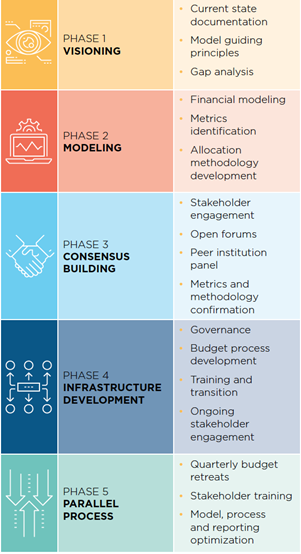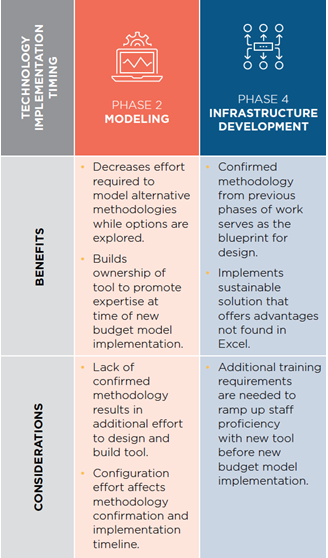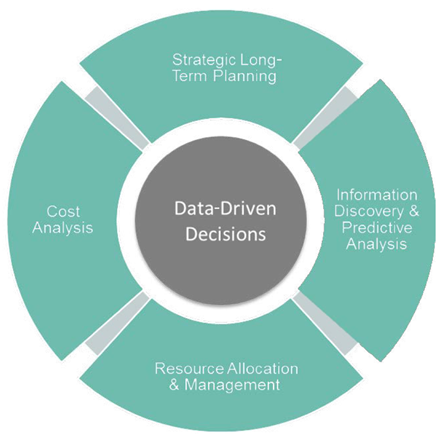In Brief
Modern Budget Model Redesign
With industrywide shifts to competitive, more volatile revenue streams, traditional expenditure-based, incremental budget models are not comprehensive enough or responsive enough to protect institutions from unanticipated shortfalls. Universities require new processes and strategically aligned allocations, as well as the tools and people skills to pivot quickly based on the latest financial results. The best budget processes are grounded in organizational cultures and are strategic, not transactional. They support year-round, two-way conversations about multiyear priorities, opportunities, capacity and anticipated outcomes, and are based on rigorous, data-informed analysis.
No ready-made budget model will work for all institutions. Inside Higher Ed’s 2017 survey of college business officers1 found that 47 percent of institutions have significantly changed their approach to resource allocation in the past four years. Huron’s experience with more than 50 institutions suggests a new model should seek to:
- Promote an understanding of net margins through transparency and intentionality of revenues, and direct and indirect costs.
- Focus on revenue growth, cost rationalization and strategic direction of revenues to the highest institutional priorities, with accountability for financial sustainability at all levels.
- Support a multiyear view of institutional financial sustainability, incorporating outward-facing strengths, weaknesses, opportunities and threat analyses of the competitive landscape across all revenue streams; institutional assets; capital investments, renewals and replacement; and major expense projections tied to a metrics-based strategic plan.
The pace of budget model redesigns is also increasing. Huron’s approach to budget redesign addresses resource management, allocation and planning initiatives. Since publishing that approach in 2012, we have incorporated a response to the changing economic conditions and needs of our institutions. Today, we believe that considering, designing, selecting and sustaining a new budget model requires a deep understanding of the specific attributes of each model, the conditions under which models have been applied and the unique attributes of institutional cultures, strategies and goals. Most important, a sequenced, data-driven, consensus-focused approach should incorporate model principles and methodologies, local unit data validation and targeted stakeholder outreach (1:1 meetings, governance groups and campus forums) to dispel myths, answer questions and secure buy-in at all levels of the organization.
Redesign Approach
The following is a five-phase approach to get from understanding and portraying current challenges and desired outcomes (visioning) to implementing a sustainable model.
Our studies of failed implementations point to a lack of institutional buy-in, a focus on the cost accounting aspects of a model at the expense of driving incentives for collaboration and/or poor change management. Making progress on these components requires building stakeholder ownership through the redesign process and recognizing that change management efforts should extend beyond implementation.
Going Beyond Microsoft Excel
Model development and institutionwide acceptance are only half of the implementation equation. Developing infrastructure and undertaking a parallel process are at least as important in bringing the model to life. A series of interlocking, often multiyear initiatives to change an institution’s culture is needed to promote sustainability. This cultural shift includes a change in decision-making roles, skills and attitudes; initiatives such as developing budget and planning governance, policies, processes and artifacts (templates, reports); and enriched institutional data that supports sufficient quality, access and granularity. Most successful institutions invest in specialized enterprise technology to broaden stakeholders’ access to timely and reliable data.
Because of the flexible and familiar functionality of Microsoft Excel, most institutions use Excel in developing their new budget model and budget templates. Once financial modeling is completed and a model methodology has been confirmed, institutions move into the budget development process, where Excel’s challenges regarding version control, system integration and data integrity create the need for more manual entry and reconciliation effort. The latest budget and planning tools:
- Seamlessly integrate enterprise financial, HR, student and space system data
- Provide Excel-like operating and capital budget/forecast data entry forms and reports
- Automate business rules and calculations
- Allow alternate scenario modeling
- Are scalable for use across multiple years and fiscal periods
When to Introduce Technology
Numerous institutions pair their budget model redesign with an enabling technology, while others wait until after their first parallel year is completed to allow for a chance to test and adapt their allocations and new budget processes.
We recommend that if you are implementing a sustainable technology as part of a budget model redesign effort, you do so during the modeling or infrastructure development phases, which the following graphic describes.
Pairing Technology With Budget Redesign
A huge driver for budget redesign success includes having a set of reliable data that stakeholders trust. Without it, building institutional consensus becomes an even greater challenge, placing implementation at risk. For many of our clients, model development exposes limitations in data structures and quality, and requires manual efforts to cleanse, consolidate and present data, which hamper streamlined analysis and reporting. While you can overcome these constraints by developing a one-time Excel model for decision making, transferring the model into ongoing operations requires a set of enabling processes and technology including the following:
Strategic, long-term financial planning models
Once the model is designed, its multiyear framework for subvention and strategic investment should be made in the context of institutional financial sustainability and include thoughtful integration of planned capital investment alternatives and driver-based operating metrics.
Resource allocation and management
All-funds, incentive-based models require an integrated plan and quarterly forecasts for direct and centrally allocated revenues/expenses and anticipated margins. Modern budgeting platforms can automate complex metrics-based allocation rules, support scenario analysis, and manage broad template distribution and validation.
Cost analysis
The focus on margins-based performance spurs deeper inquiry into metrics regarding the cost of education that supports program prioritization, fixed cost utilization, student retention/persistence and other success drivers.
Information discovery and predictive analysis
Processes and tools that help institutional research analysts extract actionable patterns in the data behind performance metrics can radically improve outcomes and ensure scarce funding is directed toward the most effective initiatives.
By implementing a comprehensive set of enabling processes and technologies, universities can position themselves to make data-driven decisions that are based on high-quality data that can be easily refreshed as new considerations are introduced into the system.
1 2017 Inside Higher Ed Survey of College and University Business Officers. A Study by Gallup and Inside Higher Ed. (2017). Inside Higher Ed.



